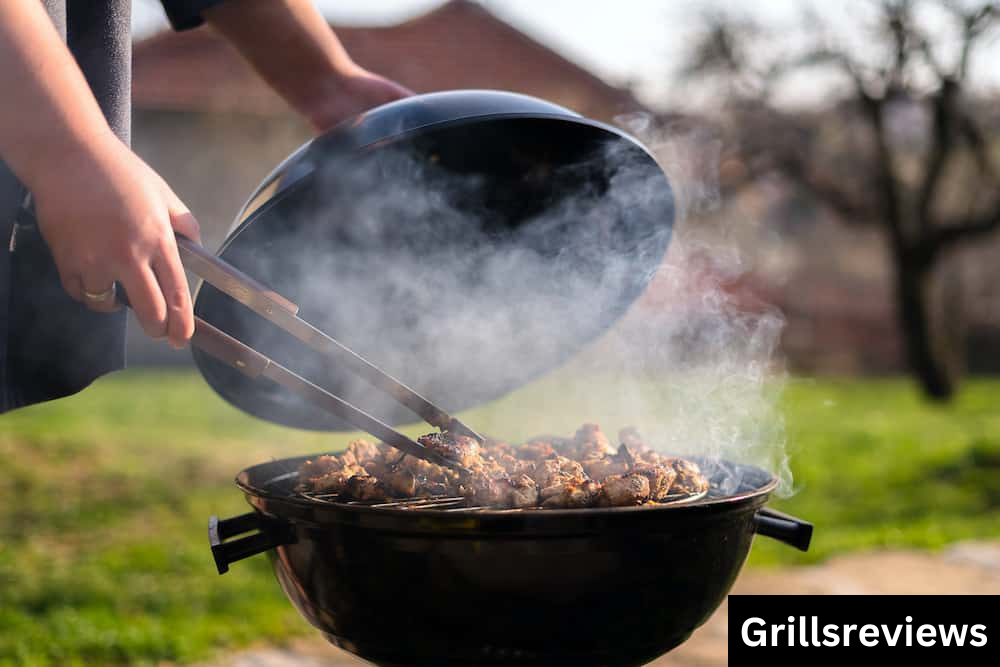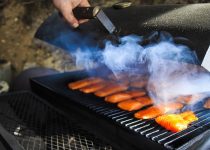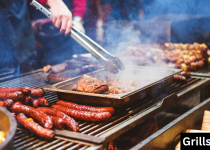How to Season a Smoker (5-Steps)

You want to season your new smoker, right?
Then you’ve come to the right place!
You recently purchased a brand-new smoker, assembled it, and purchased a fantastic chunk of meat to test it out.
However, there is one thing you need to do first: season it!
The procedure of seasoning, also known as pre-seasoning or curing, includes covering the interior of the smoker with oil and cooking it at a high temperature for the specified amount of time.
Oklahoma Joe’s Smokers says, “Seasoning a new smoker before initial use is crucial to laying the foundation for great BBQ results”.
What You Need To Know About Seasoning A Smoker?
Is it actually required? The answer is that it is essential.
Here are the primary two explanations:
To Remove Manufacturing Debris
To Prevent Rust
To Remove Manufacturing Debris
You’ll be so excited to get your new smoker out of the package that you’ll want to use it right away.
Your smoker, however, still has undesired particles from prior use.
Uncured paint, dust, adhesives, metal shavings, oils, and who knows what else from the production process are all included in this waste. By seasoning your smoker, you may avoid unpleasant flavors and odors in your food, as well as potentially harmful and hazardous impurities.
To Prevent Rust
Basically, seasoning involves baking oil onto your smoker’s surface.
It serves as a shield between your smoker and the substances that lead to corrosion.
Seasoning also aids in the paint’s cure, which deters corrosion.
Do You Need To Season The Outside Of Your Smoker Or Grill?
No, you don’t need to season your smoker’s exterior. Your smoker or grill just has to have the interior seasoned.
Why Season A New Smoker?
You will lay the groundwork for superb barbecue by following these seasoning instructions, from the first brisket to the final applewood-smoked chicken. These are the advantages:
You Remove Unwanted Odors
The smoker takes in odors from paint, glue, and the factory floor during the production process. Without preparation, these smells permeate whatever food is put inside the smoker, which is not a good thing.
You Protect Your Smoker From The Elements
Most likely, despite the fact that doing so is desirable and something you should do if you can, you won’t relocate the smoker into the garage or similar covered location after each usage. It can be better defended against the elements and harsh weather conditions with sufficient seasoning.
You Extend The Life of Your Smoker
Most likely, rustproofing is not included with your smoker. The humidity and condensation accelerate the aging of your smoker every time you use it because water and liquids are the key ingredients you’ll employ to prevent your meats and dinners from drying out. Rust can, and most likely will, start to develop eventually.
Having said that, seasoning your smoker will produce a barrier that covers its inside surfaces with smoke and carbon. This not only enables humidity to evaporate, but it also dries the paint. After several applications, it restores the appearance of your smoker.
How Often Do You Need To Season Your Smoker?
Your smoker only has to be seasoned once, and that is when it is fresh.
Even though the entire procedure will take a few hours, your smoker won’t ever need seasoning again.
Supplies You’ll Need To Season A Smoker
Here is everything you will need to properly season your smoker, keeping in mind the significance of seasoning.
Oil: Choose oils like canola, peanut, sunflower, grapeseed, etc. that have a high smoke point. Below is a complete list.
Soft Cloth: This will be used to clean the grease from the smoker’s inside.
Wood or Charcoal: A quantity that allows for two to three hours of cooking.
Mild Soap and Water: Are needed in order to clean and remove any existing oils, grime, and debris.
Types of Oils to Season a Smoker
Canola oil
Peanut oil
Sesame oil
Grapeseed oil
Vegetable oil
Gold ol’ bacon grease
Cooking Spray
Use an oil with a high burn point, no matter what you decide to use it for.
5 Easy Steps to Seasoning a Smoker
Once your smoker is unpacked and ready to use, you should begin seasoning it. Here is a step-by-step instruction manual on just how to season your smoker now that you have acquired the necessary materials.
Cleaning
Air Dry
Coating with Oil
Heating
Cool Down
Cleaning
Your new smoker can still include some unused oils, solvents, metal shavings, or uncured paint until you bring it home.
So it makes sense to spotlessly clean it to get rid of anything that can impart an unwelcome flavor or contaminate the food.
What you should do is:
The smoker’s racks, grates, and pans must all be removed.
Clean all the racks, grates, and pans with water and mild dish soap.
Repeat for the firebox and the rest of the smoker’s interior.
Air Dry
Allow everything to air dry after cleaning.
To make the following step much simpler, put off assembling the pieces until later.
Coating with Oil
Next, you need to gather some oil with a high burn point.
It will work with a cooking oil like canola or grapeseed oil.
After heating, this kind of oil will form a good, hard protective surface through a process known as polymerization (for a list of various oils and alternatives, see the suggestions section below).
What you should do is:
Apply a thin layer of oil to the door or lid and the interior walls of a smoker that is empty. You may apply this with a soft cloth or a can of cooking spray.
Use the same procedure to coat the grates and racks. The water pan shouldn’t be coated, although you can if you like. Most sites don’t advise it.
Before beginning the heating process, let the oil soak in for five to ten minutes.
Note: Make sure to cover every possible crevice!
Heating
It’s time to start smoking now! Place the water pan there, but don’t fill it with water. Light the charcoal or wood you’ve used to fill the smoker.
It should be allowed to heat up and finish the cooking cycle. This will guarantee that any manufacturing-related chemicals or solvents are burned off.
Run the grill for a couple of hours.
To enable the most ventilation, make sure all intake and exhaust vents are open. For the best results, the temperature should be higher than the standard cooking temperature.
Attempt to reach a high temperature of at least 400 °F. Set the temperature to the highest setting on gas and electric smokers.
Note: Choose the same kind of wood that you’ll actually use for cooking.
Cool Down
Check the protective layer’s effectiveness by opening the lid.
Dark brown should be the color of the inside. If so, let the smoker cool before clearing the ashes.
Re-Seasoning Your Smoker
The soot or grease buildup on the smoker’s internal walls may eventually start to affect the flavor or moisture content of your meal.
By repeating the preceding processes, you should treat it as if it were a brand-new component of your outdoor cooking equipment, in this case:
Wash all the interior pieces
Air dry them
Re-coat the surfaces with oil or grease
Heat the smoker up again (To bring it back to its former splendor!)
Final Thought
You’re now all set to have a BBQ.
Seasoning your smoker may take a bit more time and work on your part, but it will pay off in the end. Seasoning will give your smoker a longer shelf life and improve the quality of your smoking experience.
Who exactly wants their meat to cling to the grill? Not from me.
Of course, everyone wants their barbecue to be flavorful, flawless, and devoid of rust. All of it begins with giving your smoker a thorough seasoning.
Why are you holding out? Do some seasoning!
Related Posts

Best Smokers For Sausage

How long do Gas Grills last
